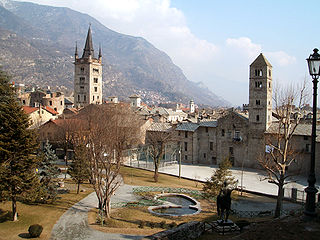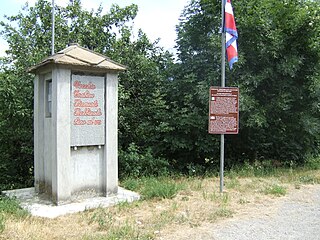History
It first became an autonomous fief in 1619 when Giovanni Carron received the fiefs of Buttigliera, Uriola, and Case Nicola - as well as the title of Count - from Duke Charles Emmanuel I of Savoy.
From that point in time the history of Buttigliera was intimately tied with the history of the Carron family. The last member of the family, Clementina Carron, died in April 1912.
In the 20th century, the FIAT group established one of its metallurgical factories in Ferriera, a frazione of Buttigliera Alta.
"Frazione" is the Italian name given in administrative law to a type of territorial subdivision of a comune; for other administrative divisions, see municipio, circoscrizione, quartiere. It is cognate to the English word fraction, but in practice is roughly equivalent to "parishes" or "wards" in other countries.
Carron Giovanni was the First Duke of Buttigliera Alta. He was conferred the title as well as the fiefdom of the area, on April 25, 1619. His family, the Carrons, originated from Savoy, and established themselves in Turin in 1600, at the Lascaris Palace.
Carron Clementina was the granddaughter of Count Carron Giovanni. She was born in Turin.

Susa is a town and comune in the Metropolitan City of Turin, Piedmont, Italy. In the middle of Susa Valley, it is situated on at the confluence of the Cenischia with the Dora Riparia, a tributary of the Po River, at the foot of the Cottian Alps, 51 km (32 mi) west of Turin.

The Dora Riparia is an alpine river, a left-hand tributary of the Po. It is 125 kilometres (78 mi) long, with a 1,231-square-kilometre (475 sq mi) drainage basin. It originates in the Cottian Alps, close to the Col de Montgenèvre in France, where it is called the Piccola Dora. Its name becomes the Dora Riparia after the confluence with the Ripa in the Argentera Valley and the Thuras de Bousson close to Cesana.

The Susa Valley is a valley in the Metropolitan City of Turin, Piedmont region of northern Italy, located between the Graian Alps in the north and the Cottian Alps in the south. It is the longest valley in Italy. It extends over 50 km (31 mi) in an east-west direction from the French border to the outskirts of Turin. The valley takes its name from the city of Susa which lies in the valley. The Dora Riparia river, a tributary of the Po, flows through the valley.

Bruzolo ) is a comune of the Metropolitan City of Turin in the Italian region Piedmont. Located some 43 kilometres (27 mi) west of Turin, in the lower Susa Valley, it is a member of the Comunità Montana Bassa Valle di Susa e Val Cenischia. Bruzolo borders the following municipalities: Usseglio, Condove, Chianocco, San Didero, and San Giorio di Susa.

Gravere is a comune (municipality) in the Metropolitan City of Turin in the Italian region Piedmont, located about 50 kilometres (31 mi) west of Turin. Until 1713, it was the first commune in the Val di Susa in the Duchy of Savoy when coming from France, as the upper part of the valley was part of the latter kingdom.

Lanzo Torinese is a comune (municipality) in the Metropolitan City of Turin, region of Piedmont, northwestern Italy. It is located about 30 kilometres (19 mi) northwest of Turin at the mouth of the Valli di Lanzo.

Meana di Susa is a comune (municipality) in the Metropolitan City of Turin in the Italian region Piedmont, located about 50 km west of Turin.
Meana di Susa borders the municipalities of Susa, Gravere, Mattie, Usseaux, and Fenestrelle.

Moriondo Torinese is a comune (municipality) in the Metropolitan City of Turin in the Italian region Piedmont, located about 20 kilometres (12 mi) east of Turin.

Oulx is a comune (municipality) in the Metropolitan City of Turin in the Italian region Piedmont, located about 70 kilometres (43 mi) west of Turin, in the Susa Valley on the border with France.

Reano is a comune (municipality) in the Metropolitan City of Turin in the Italian region Piedmont, located about 20 kilometres (12 mi) west of Turin.

Vaie is a comune (municipality) in the Metropolitan City of Turin in the Italian region Piedmont, located about 35 kilometres (22 mi) west of Turin in the Susa Valley. As of 31 December 2004, it had a population of 1,413 and an area of 7.1 square kilometres (2.7 sq mi).

Castelnuovo Don Bosco is a comune (municipality) in the province of Asti in the Italian region Piedmont, located about 20 kilometres east of Turin and about 25 kilometres northwest of Asti, on a hill near the confluence of the Nevissano and Bardella.
The March or Marquisate of Turin was a territory of medieval Italy from the mid-10th century, when it was established as the Arduinic March. It comprised several counties in Piedmont, including the counties of Turin, Auriate, Albenga and, probably, Ventimiglia. The confines of the march thus stretched across the Po Valley from the Western Alps in the north, to the Ligurian Sea.

Adelaide of Turin was the Countess of part of the March of Ivrea and the Marchioness of Turin in Northwestern Italy from 1034 to her death. She was the last of the Arduinici and is often incorrectly associated with Susa. She is sometimes compared to her second cousin, and close contemporary, Matilda of Tuscany.

The Abbey of Sant'Antonio di Ranverso is a religious complex in Buttigliera Alta, province of Turin, northern Italy.

Torino Porta Susa is a railway station in Turin, northern Italy; it is the second busiest mainline station in the city, after Torino Porta Nuova. It is located in Corso Inghilterra.
Bicocca, meaning a small castle located in an elevated place, is a common term in Italian toponymy, It may refer to:

Baratuciat is a white Italian wine grape variety that is grown in the Piedmont wine region of northwest Italy. For most of its history, Baratuciat was used mainly as a table grape with some limited use for wine production with sweet late-harvest dessert wines. On June 23, 2008, the grape was officially added to the Italian registry of wine grape varieties.























